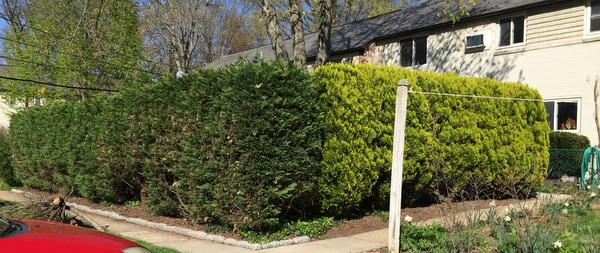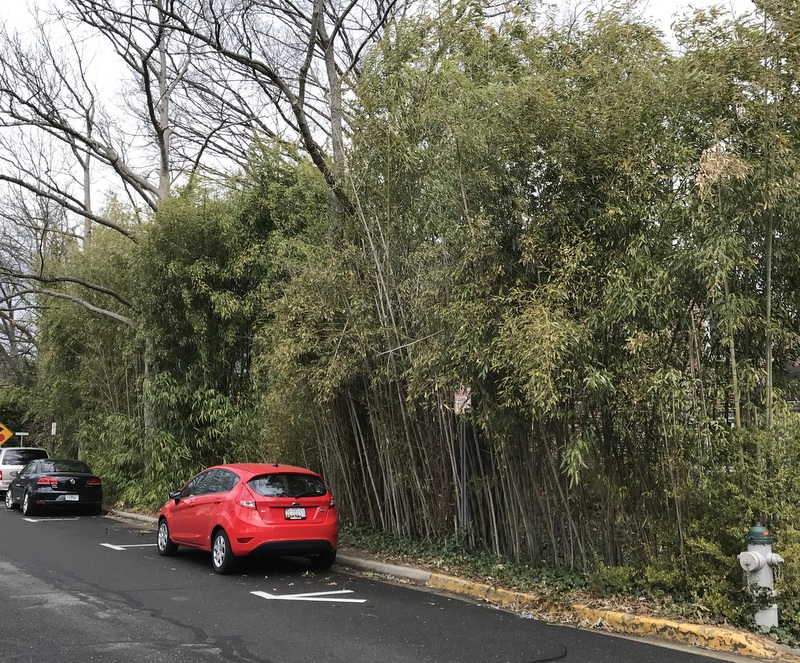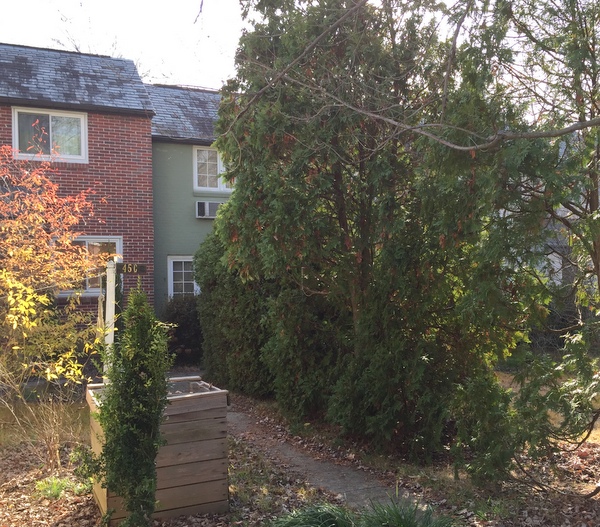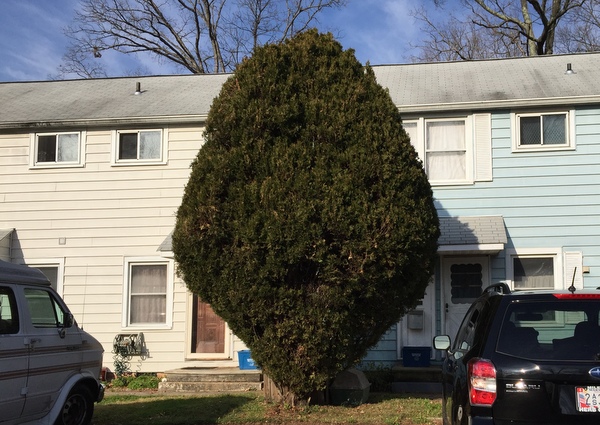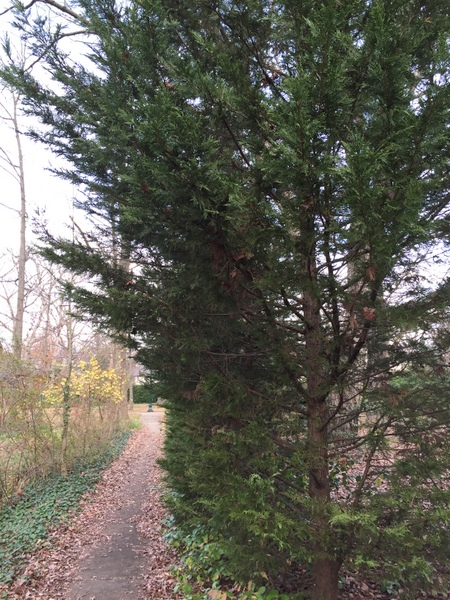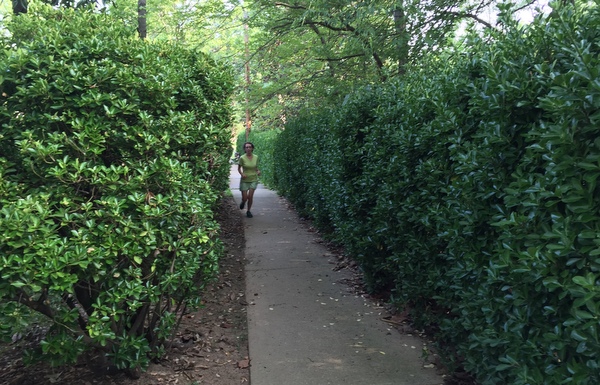INTRODUCTION
GHI’s Task Force on Yard Solutions for a 21st Century Garden City conducted a member survey of issues and problems members experience with their yards, as authorized by the GHI Board, in 2017. Based on the surprisingly large response to the survey and their content, the Task Force took a big-picture approach and studied GHI yards from the following perspectives:
- Environmental stewardship of GHI’s collective landscape for increased diversity, stormwater management, more provision for wildlife, and the addition of low-maintenance/low-input plants.
- Beautification, for the resulting increase in curb appeal and pride in community, and in fulfillment of GHI’s Vision Statement, which begins: “We will provide affordable, well maintained homes in an attractive cooperative community.”
- Appreciation of and respect for our historically significant open landscape.
- Encouraging and facilitating (rather than impeding) members’ ability to garden and enjoy their own yards, thus benefiting the members themselves, the environment (through members’ additions of plants to their yards, which is especially important as our original trees near the end of their lifespan), and property values.
- Safety and walkability of GHI’s sidewalks.
- The need for rules and procedures that are easily understood and are perceived as necessary, fair, and member-friendly
CONSTRUCTED SCREENS
Background: Greenbelt’s original plan was for homes to be accessed not by cars but by inner pedestrian walkways. Therefore the original landscape plan provided for open expanses of turfgrass in both garden and service-side yards, surrounded by very low hedges along the inner sidewalks and no fencing or screening allowed (either by using tall plants or built structures). GHI yards in the older units were surrounded by 3′ tall privet hedges.
Sometime after GHI was created in 1952 and residents became owners/members (not renters), a small amount of built screening was allowed for each garden-side yard, in recognition of the reality that garden-side yards were used as back yards after all and screening especially from close neighbors was needed. The amount of built screening allowed was and still is: up to 2 screens of up to 48 square feet each and no taller than 6 feet (typically in a 6 x 8-ft configuration), with the stipulation that the 2 screens be at least 4 feet apart.
The Needs
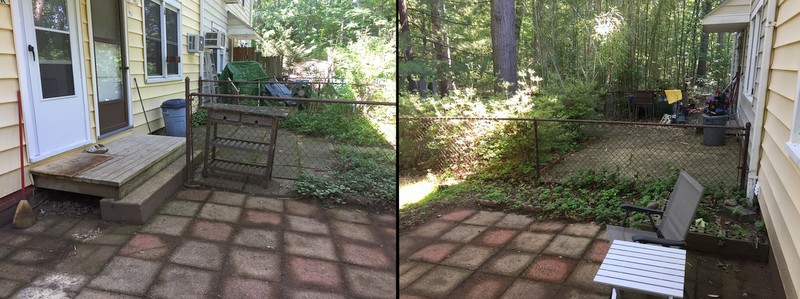
Members need screening for these primary reasons:
- For privacy, especially between members and their next-door neighbors (in order to use their patios/yards without having to include the neighbors) AND from passersby on streets and sidewalks.
- To create gardens. Gardens begin with enclosure, with vertical elements that create private or private-seeming spaces or outdoor rooms.
- To block unsightly views; e.g. of a parking lot, of a storage area.
Lack of adequate screening has resulted in severely restricting members’ use of their yards for socializing, quiet relaxation, gardening and other uses, especially where next-door neighbors both use their garden-side yard. (Typical townhouse back yards are surrounded by 8-foot fencing, to allow maximum privacy.) Members cannot simply use lattice instead because under the rules, lattices that screen are covered by the same restrictions.
While many members have no desire to spend time in their yards, those who do find their lives greatly impacted by GHI rules – rules that are difficult to understand or justify and are at cross-purposes with GHI’s current hedge rules.
GHI yards are far too different from each other for a one-size-fits-all screening solution to meet members’ needs. Plus, members themselves vary widely in how they want to use their yards – or whether they want to use them at all. Their next-door neighbors may or may not ever use their back yard.
Many members with screening needs simply ignore the current rule, jerry-rigging extensions on top of fencing, hanging sheets or using other makeshift, temporary-type solutions, generally much less attractive than a constructed screen of adequate size.
[In our member survey, many cited the need for more privacy; 63 said they were not happy with privacy between their yard and neighbors’. There were also reports of unsightly views that need to be screened.]
Vision/Goal for Built Screening
To find practical, affordable solutions to members’ screening needs that also:
- Minimize anti-social walling off of member yards and maximize community openness, thereby respecting and preserving Greenbelt’s historically significant openness.
- Complement GHI architecture and are attractive additions to our shared landscape.
- To the extent possible, install screens at least several feet away from sidewalks, thereby protecting pedestrian safety and members’ feeling of safety, both critical to Greenbelt’s walkability.
Recommended Solution: Screening/Garden Design Help for Members
Fortunately, GHI has members qualified to help other members create gardens or solve other screening problems, and they’re eager to help. We recommend establishing a Gardening Team or Task Force reporting to the ARC (which would arise out of the Yards Task Force but open to all with gardening and garden design expertise) to respond to requests for screening design help by visiting the yard, talking with the members and suggesting solutions, such as the following:
- Targeted and limited man-made screen or trellis (like screening but more open) built around or along a patio rather than along the lot line and sidewalk.
- Where privacy is paramount – e.g. between next-door neighbors – up to 6′ tall man-made screens of adequate length to meet the need, which is determined primarily by the location of sitting areas in each yard.
- Fast-growing plants where space is adequate, but planted close to seating areas in the yard rather than along the sidewalk. (Keeping tall plants at lest several feet away from sidewalks is critical to preserving sidewalk safety and walkers’ perceptions of safety. .
- Mounting of blinds (currently prohibited) that can be lowered to provide screening when needed and stored for the winter.
- Trellises composed of horizontal and vertical lines, not diagonal lines, thereby complementing, not clashing with GHI’s dominant architectural features.
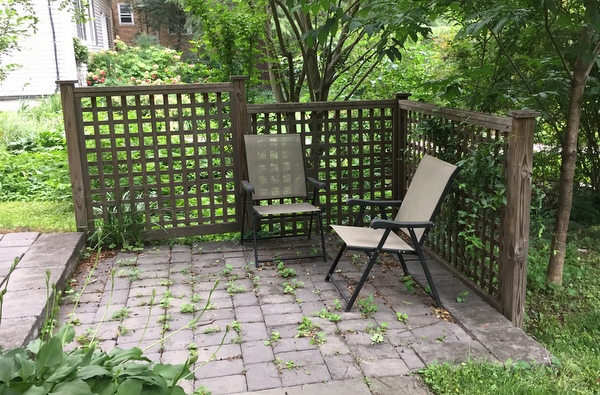
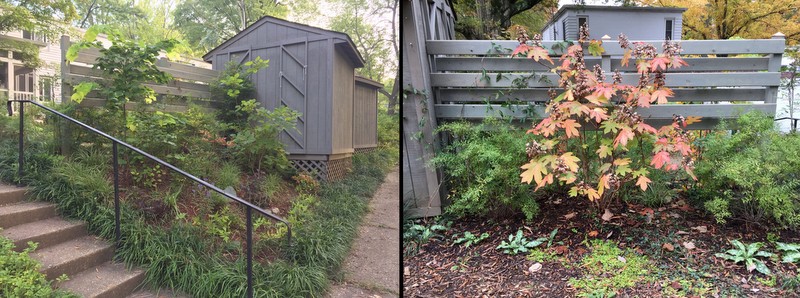
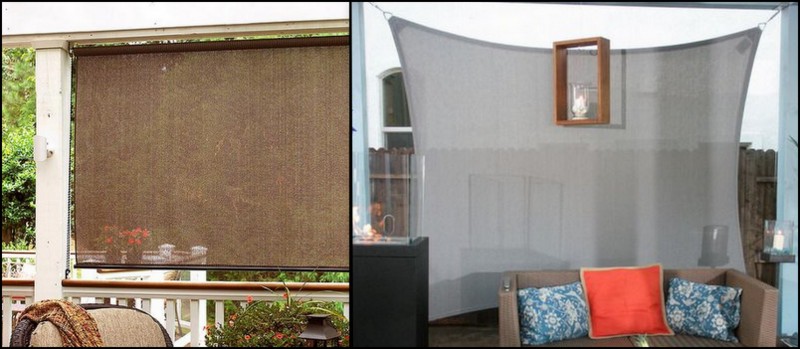
CLICK HERE for more examples of man-made screening types.
If a member/applicant chooses one of the Task Force’s recommended solutions, the member’s application would proceed to Tech Services for the usual approval and then distributed to all ARC members, If no ARC member requests a full hearing on it, the application would be approved at that point. Thus, members’ problems could be solved and the community made more beautiful without creating new burdens on the ARC and the Board – or the members themselves.
Successful screening solutions (that meet the goals above) would be photographed and collected to give other members ideas for their screening solutions. The process could be simplified/shortened in the future as more good examples are become available.
LATTICE
It’s generally not understood by members that under the current staff interpretation of GHI rules, all lattices that provide screening are required to follow the same rules and procedures as privacy screens, so that needs to be made explicit in the rules
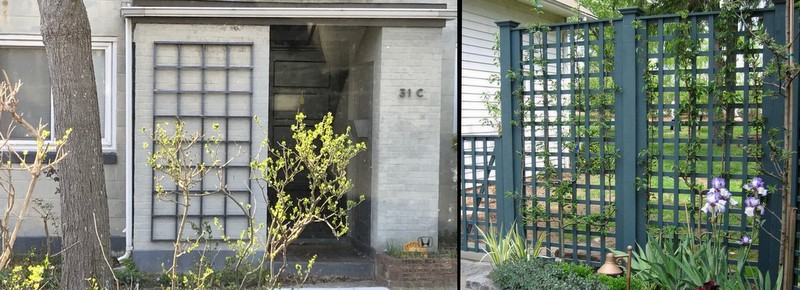
.
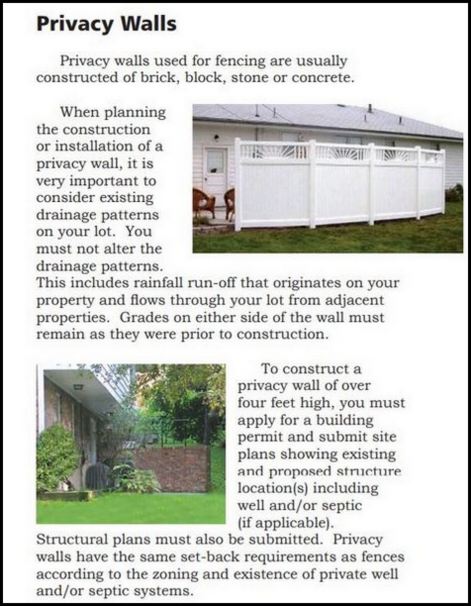 Lattices that do NOT provide screening (because they’re up against a house or shed, for example) would be allowed without a permit if they are constructed of horizontal and vertical lines (as in the photos above), which complement and enhance GHI’s architecture. Existing diagonal lattice should be grandfathered but new diagonal lattices not allowed.
Lattices that do NOT provide screening (because they’re up against a house or shed, for example) would be allowed without a permit if they are constructed of horizontal and vertical lines (as in the photos above), which complement and enhance GHI’s architecture. Existing diagonal lattice should be grandfathered but new diagonal lattices not allowed.
Recommendation to Reducing Expense and Permitting Hurdles
Page 10 of information about Prince George’s County rules governing permitting (seen on the right) state that a “privacy wall over four feet high” requires a County permit before it’s built. GHI’s Tech Services staff currently interprets that to apply to trellises.
In order to avoid unnecessary expense and delay for members seeking to install trellises, the Task Force requests that staff reconsider this interpretation of County privacy wall regulations to instead exempt trellises, which are porous by definition and very unlike the solid tall “privacy walls used for fencing” illustrated here in the county’s rules.
HEDGES
Background: A hedge height maximum was in place from GHI’s early days until 2008 when the limitation (then a 5-feet maximum) was removed completely (except where court entrances intersect with the street). Since then, the number of tall hedges has increased, including those surrounding both service- and garden-side yards. This results in virtual walls of evergreen that greatly reduce users’ feeling of safety.
These evergreen walls are also in opposition to Greenbelt’s historic and unique open plan, which is also enshrined in the GHI Mission Statement that “We will maintain, protect and enhance the assets of our cooperative including the buildings, architectural designs, open space plan (woods, walkways, playgrounds), while preserving the financial stability and sustainability of our cooperative community.”
Current Needs/Problems
The combination of no limit on hedge height and severe limitations on built screens has and continues to force more members to install hedges as their only screening option. Plus, hedges are recommended in the GHI Members’ Handbook as a landscape feature for GHI yards, despite the many problems caused by their use, especially in small spaces like GHI yards.
Problems caused by hedges – a landscape feature from the bad old days:
Safety:
- Unless pruned regularly and skillfully, hedges create persistent obstacles to pedestrian safety: branches and other overgrowth that can injure and/or deposit ticks onto passersby (including disease-bearing ticks so common in Greenbelt now).
- Especially when taller than pedestrians, hedges create an unsafe-feeling tunnel effect that is counter to GHI’s historic openness and focus on walkability. Hazards increased by tall hedges include falls or injuries due to unkempt surfaces or overgrown vegetation, as well as crime.
- Especially along lot lines between next-door neighbors, hedges create long-lasting and difficult-to-remove obstacles to entry and exit/passage to front door, etc
Difficulty in Growing:
- Hedges are high-maintenance. Pruning of hedging is a specialized skill, and very time-consuming.
- Hedges are difficult to impossible to grow in many GHI yards due to shade and/or lack of adequate space.
- Unsustainable monocultures (single-species plantings) like hedges are prone to disease AND are lacking in biodiversity.
- Species planted for hedges can turn out to have the wrong form to screen adequately
- The most common species used in GHI hedges are not well suited to our climate – euonymus being very prone to disease and privet being invasive in our region.
- Hedges are not recommended by current environmental and horticultural experts and are rarely installed today for these and other reasons.
Other drawbacks:
- Successful screening can easily take 5-10 years to achieve.
- Screening with hedges is usually more expensive than with built structures.
Recommended Solutions for Hedge Problems
- Remove recommendations in the GHI Members’ Handbook that hedges be installed. Instead, provide accurate information to members about the care of hedges and alternatives to them. Encourage members to plant new plants that could become taller than 4′ at least 10 feet away from sidewalks.
- Reinstate the height limit on hedges – not the 5′ limit used until 2008 but 6′, which is adequate for screening purposes. Hedges could be checked for height at the time of the Community Beautification inspection, and normal plant growth taller than 6′ between those times would be allowed.
- If cut back to 6′ the natural forms of existing hedges of conifers, hollies and Photinia would be destroyed, so those hedges would be grandfathered at their existing height. Planting of new hedges of conifers, hollies or Photinias would be allowed only by exception (for which the ultimate size of the plant would have to be appropriate.)
- The GHI Gardening Team or Task Force would conduct in-person pruning workshops and other education about the care of GHI’s hedges.
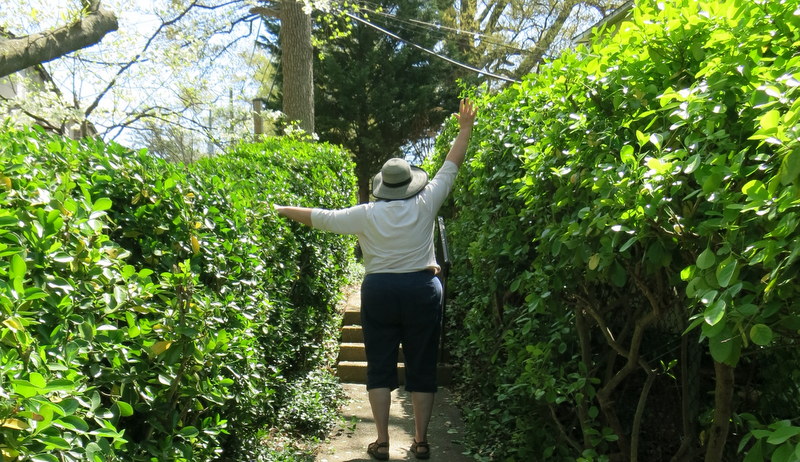
FENCING OF MEMBER YARDS
History: No fencing of member yards was allowed until the creation of GHI in 1952, when occupants became member-owners who were allowed to have dogs. At that time there was no determination as to the best styles of fencing for individual members or the community; members were and continue to be free to choose any style.
The Need/Problem
Fencing in our community has an enormous impact on the overall beauty and cohesiveness of the GHI landscape and of Historic Greenbelt, including its attractiveness to potential home-buyers. For this reason, planned communities typically require that fences be in appropriate, preselected styles and materials. GHI is unusual in not doing so.
[Fencing styles/types: 59 survey responders complain of fencing types in GHI, many mentioning their desire for less chainlink.]The Vision/Goal for GHI Fencing:
- Less fencing overall, to preserve and enhance Greenbelt’s original and iconic openness.
- Fencing, when used, that meets member needs yet complements GHI architecture and is an attractive asset to the community (at a range of price points).
- Architecturally appropriate fencing styles are those that emphasize horizontal and vertical lines, rather than diagonals, curves or other embellishments.
- Natural materials and natural-looking materials in fencing are preferred because they enhance the community’s appearance of greenness and commitment to sustainability.
Suggested Solutions
- Require that new fencing be in one of these styles chosen by the ARC. (CLICK HERE for fence styles, with options at all price points). Members seeking new fencing in nonconforming styles or materials may apply for an exception to this rule.
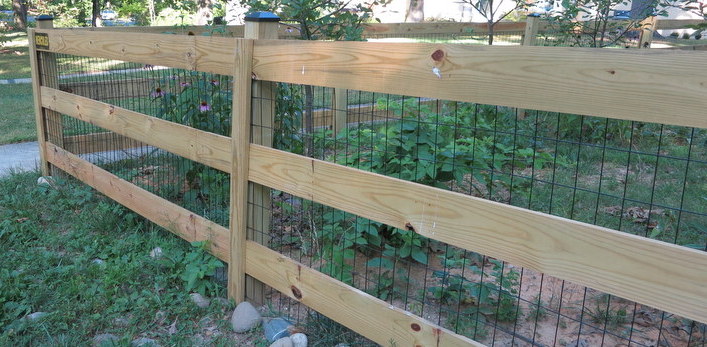
- GHI continue its practice of removing fences at no cost to the member as long as no new fencing is installed within 2 years of the removal of the original fence.
- Remove VII.B.1.9: “Fence styles within the row should harmonize.” (New rules would emphasize harmonious fencing throughout the community, not just in individual courts.)
- When existing chainlink fencing is repainted, it must be painted black (with GHI providing the paint).
More Help for GHI Gardeners and Gardeners-to-Be
Gardening help needed: 155 respondents said improving their garden was important and 147 said reducing yard maintenance was. Many responders want help with providing for wildlife (e.g. mentioning natives, pollinators). Preferred sources of help/information included: GHI website, Communicator, and E-News; instructional open gardens, workshops (pruning, etc); and social media. Many want consultations for their individual yards. For shady yards, members want information about lawn in shade, and suitable lawn alternatives, what edibles and other plants will grow in shade.
Solution: Changes to privacy screen rules suggested herein would help members create gardens. In addition, a Gardening Team or Task Force to be established would:
- Offer in-person instruction in pruning.
- Offer personalized garden design and plant coaching for members who desire it (at a frequency to be determined by the Gardening Team; e.g., 4 yards each spring and fall.)
- Provide Open Garden events in gardens of team members and other GHI gardens throughout the season – for social and learning purposes.
- Review gardening and plant information on the GHI website and recommend corrections and additions, referring members to the U. Maryland Home and Garden Information Center as a trusted and accurate source.
Appendices
- Yard Task Force Appendix Final includes background about the YTF and its further actions in response to member survey, plus how other planned communities treat these issues
- Executive Summary Yard Task Force Report to Board
- Yard Survey Responses – Full Report
- Summary of Yard Survey Responses
Task Force Members
Members of the Yard Solutions for a 21st Century Garden City Task Force are:
Susan Harris, chair
Stefan Brodd, Board liaison
Nancy Newton
Julie Winters
Rob Baluch
Rachel Channon
Geraldine Adams
Annie Shaw
Pat Novinski



